Between towering limestone karsts and mist-covered valleys, Lung Ho village stands as one of Ha Giang’s most captivating yet overlooked treasures. This remote hamlet offers travelers a glimpse into authentic ethnic minority life while surrounded by some of northern Vietnam’s most breathtaking landscapes. At Phieu Travel, we’ve explored the hidden corners of Lung Ho Ha Giang extensively, discovering its unique charms beyond the typical Ha Giang Loop highlights. Join us as we unveil this cultural and natural wonderland tucked away in Vietnam’s northern frontier.
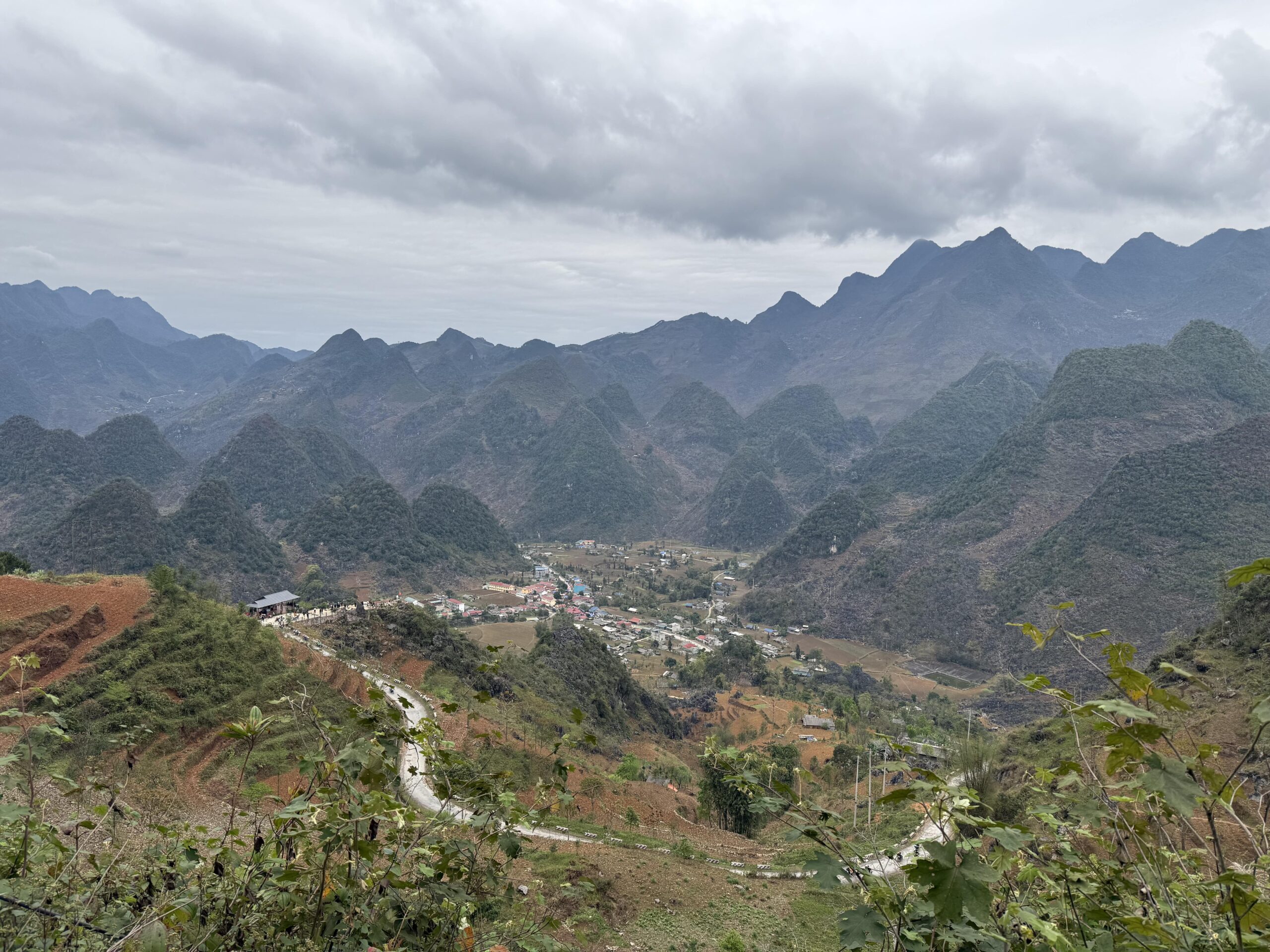
1. Overview: what & where is Lung Ho?
Nestled in the majestic karst landscape of Ha Giang Province, Lung Ho is a small ethnic minority village that often escapes the attention of mainstream tourism. Located approximately 25 kilometers from Dong Van town, this remote settlement sits quietly among terraced rice fields and dramatic mountain scenery. The village belongs to the greater Ha Giang Loop circuit but remains relatively untouched compared to more frequented stops like Quan Ba or Ma Pi Leng Pass.
Lung Ho’s name translates roughly to “valley of abundance” in the local dialect, reflecting the relatively fertile soil found in this mountain pocket. Unlike many villages that have adapted to cater to tourists, Lung Ho maintains its traditional character, with stone houses clustering along narrow pathways and agricultural fields spreading across available flat land. Most residents belong to the Hmong and Tay ethnic groups, preserving centuries-old customs, agricultural techniques, and distinctive architectural styles that define their cultural identity.
The village sits at an elevation of approximately 1,200 meters above sea level, contributing to its pleasant climate and spectacular panoramic views. Surrounded by terraced fields that change colors with the seasons, Lung Ho offers photographers and nature enthusiasts an authentic glimpse of rural highland life. From its strategic position, visitors can observe daily activities unfolding against the backdrop of imposing limestone formations that characterize this UNESCO-recognized geopark region.
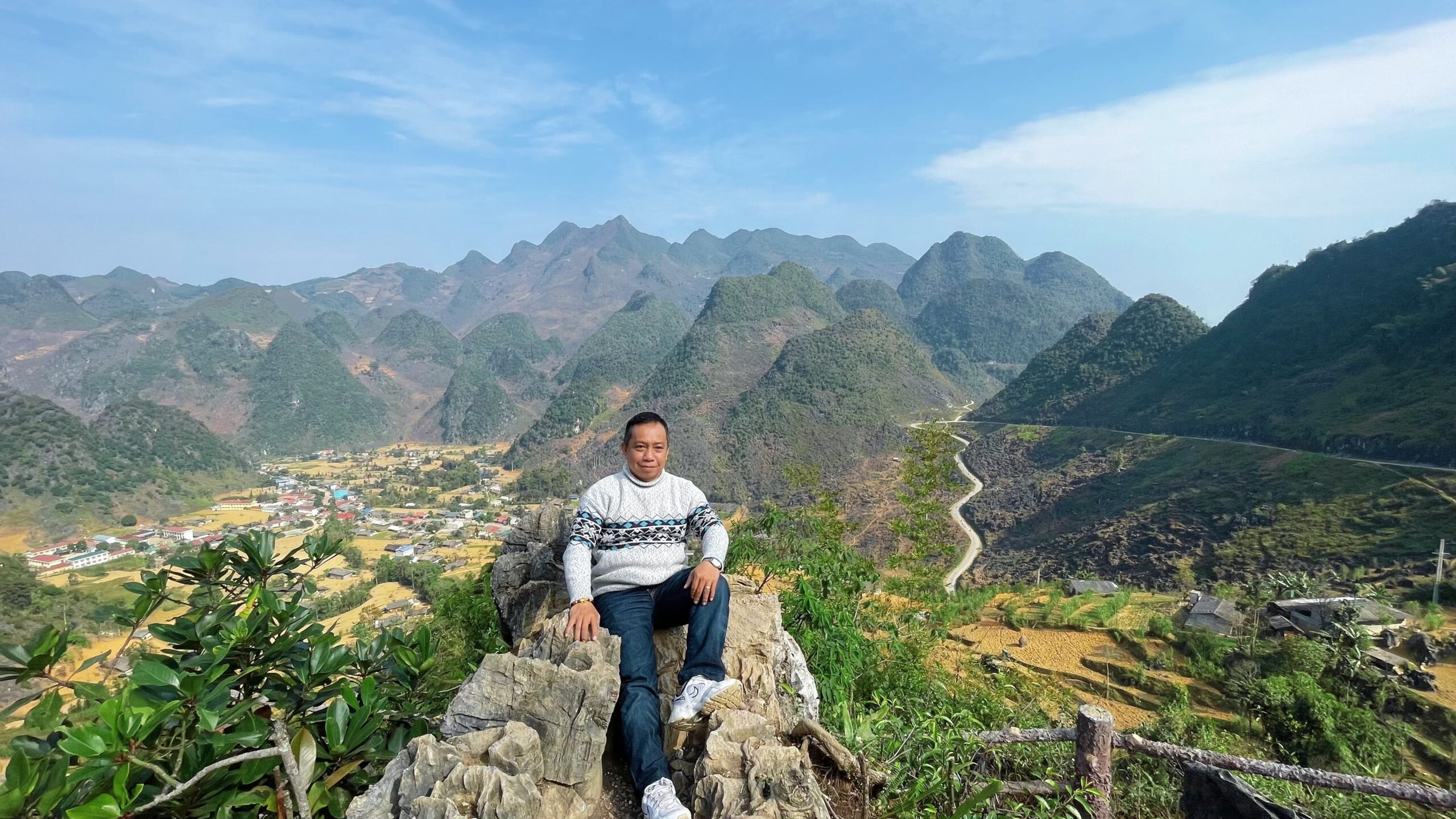
The Ultimate Ha Giang Loop Guide (2025): Itinerary, Map & Tips
2. Why visit Lung Ho: natural & cultural highlights
Lung Ho offers a unique blend of natural beauty and authentic culture, making it a distinct destination in Ha Giang. Unlike other commercialized stops on the loop, this village remains largely untouched by mass tourism, preserving a way of life passed down through generations.
2.1 Natural Beauty
Lung Ho is surrounded by a dramatic landscape of limestone peaks and cascading rice terraces that change with the seasons. The Lung Ho Valley Vista is especially renowned for its panoramic views, perfect for photography. The setting feels otherworldly, particularly when morning mist fills the valley.
2.2 Cultural Immersion
The village provides a genuine cultural experience with its Hmong residents. You can witness their traditional lifestyle, from the indigo clothing they wear to their unique agricultural practices. Their stone houses, built using traditional methods, and the intricate textiles woven by the women offer a glimpse into their rich heritage. Unlike other tourist spots, cultural interactions here feel real and personal, not staged.
2.3 A Hub for Exploration
Lung Ho is an ideal base for exploring the surrounding area. Hiking trails lead to remote settlements and hidden waterfalls. Its central location also makes it easy to visit popular spots like the Dong Van Market or Ma Pi Leng Pass before returning to the peaceful village. For travelers seeking a combination of natural splendor, cultural discovery, and authentic local encounters, Lung Ho is an exceptional choice.
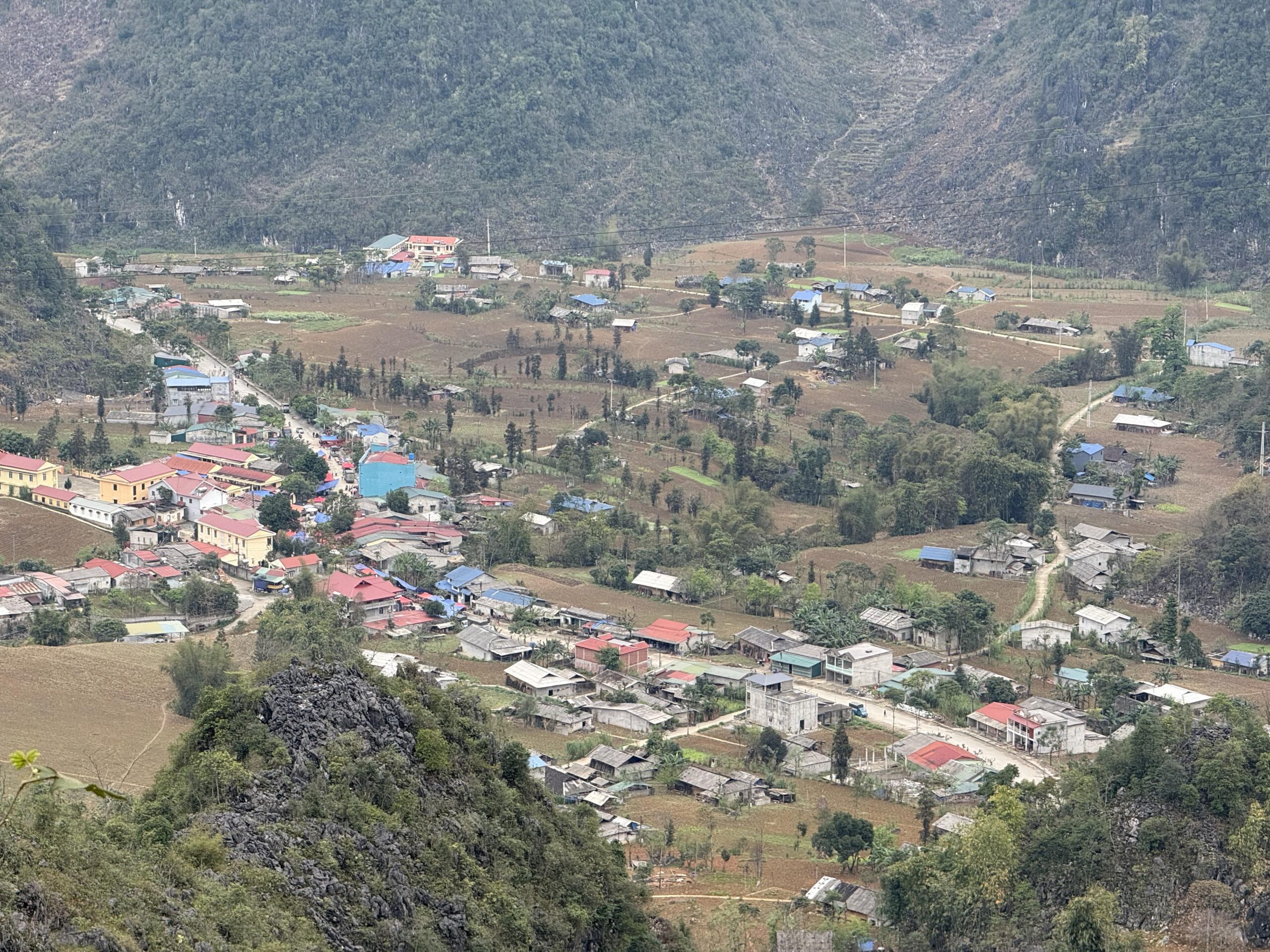
3. How to get to Lung Ho (Tour or DIY)
Reaching Lung Ho requires some planning, but the journey itself becomes part of the adventure through Ha Giang’s magnificent landscapes. Travelers have several options depending on their preferred level of independence, time constraints, and comfort preferences. At Phieu Travel, we recommend considering these approaches carefully, as each offers different advantages for experiencing this hidden gem.
3.1 Renting a Motorbike
For independent travelers comfortable with mountain driving, renting a motorbike in Ha Giang city provides the most flexibility. The route to Lung Ho follows the main Ha Giang Loop road toward Dong Van, with a turnoff approximately 15 kilometers before reaching the town. Look for a small sign indicating “Làng Lũng Hồ” and follow the narrow road for about 7 kilometers until you reach the village center. The road conditions vary seasonally generally good during dry months but potentially challenging after rain. A semi-automatic or manual motorcycle (125cc or higher) handles the terrain best, and proper riding gear remains essential for safety on mountain roads.
3.2 Joining an Organized Tour
Joining an organized tour offers a more relaxed alternative while providing cultural context through knowledgeable guides. Phieu Travel specializes in small-group experiences that include Lung Ho as part of customized Ha Giang itineraries. Our local guides speak both Vietnamese and ethnic minority languages, facilitating meaningful interactions with villagers. Tours typically include transportation in comfortable vehicles, accommodation arrangements, and curated experiences that would be difficult to organize independently. This option works particularly well for photographers, cultural enthusiasts, or those with limited time who want to maximize their experience.
3.3 Hiring an “Easy Rider”
The “Easy Rider” approach combines elements of both methods hiring a local driver who takes you on their motorcycle while sharing local knowledge. This option proves especially valuable for solo travelers or those uncomfortable driving mountain roads themselves. Many Easy Riders from Ha Giang city or Dong Van know the back roads to Lung Ho and can introduce you to local families. Costs typically range from 500,000-700,000 VND per day including fuel, with drivers often helping arrange homestays in the village.
Public transportation presents significant challenges for reaching Lung Ho directly. The closest you can get via public bus is Dong Van town, from where you’ll need to arrange a motorcycle taxi (xe ôm) for the remaining distance. Local drivers generally charge 150,000-200,000 VND for this service. While budget-friendly, this option requires more time and basic Vietnamese language skills for negotiation.
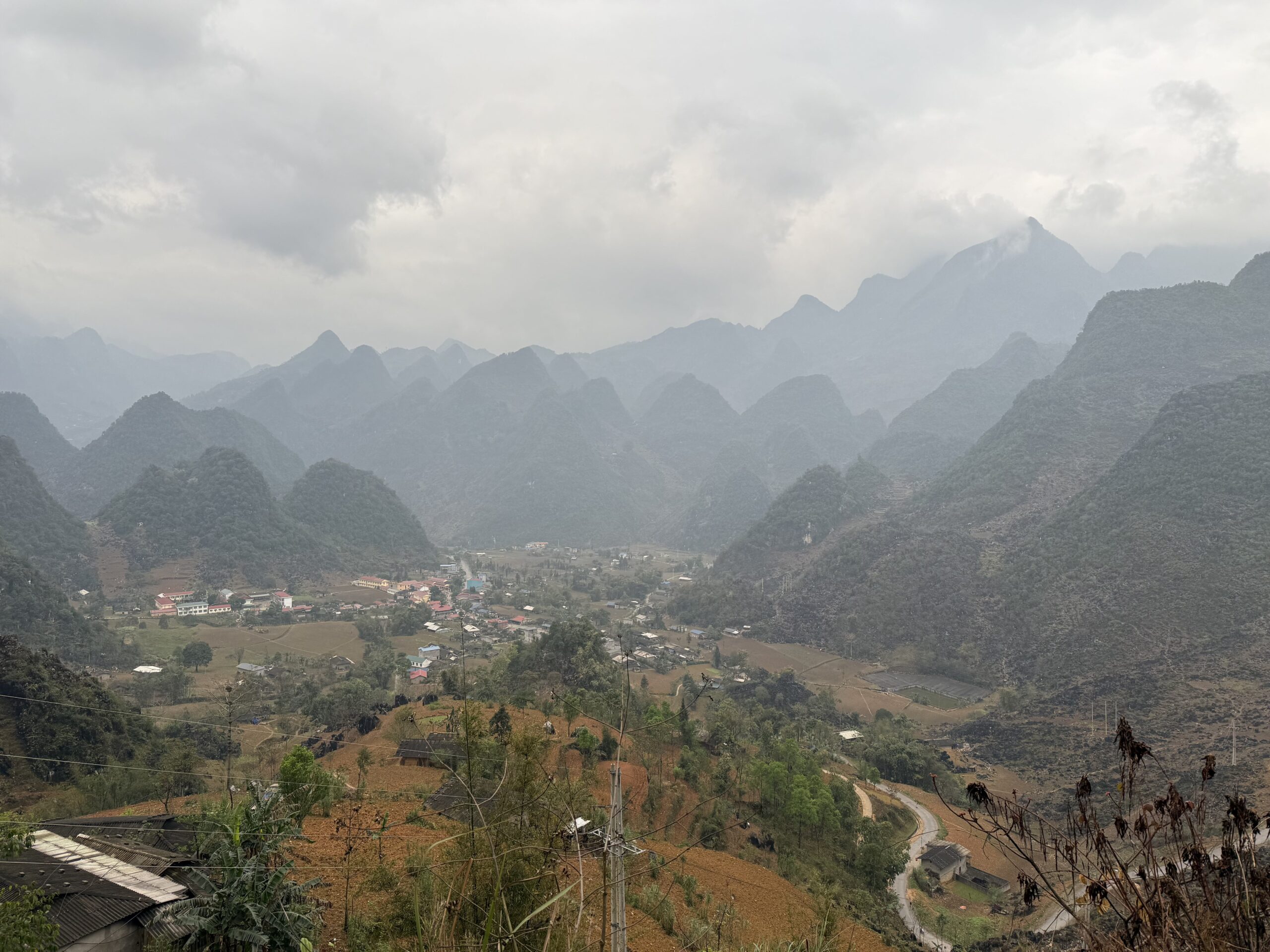
Ha Giang Motorbike Loop: The Ultimate Tour with Phieu Travel
4. Top things to do in Lung Ho
Lung Ho rewards visitors with authentic experiences that showcase both its natural beauty and rich cultural heritage. Unlike more developed tourist spots, the activities here focus on genuine engagement with the landscape and the local way of life.
4.1 Trekking to the Lung Ho Panoramic Viewpoint
This is one of the most rewarding activities. A moderately challenging 45-minute hike from the village center leads to an elevated ridge with breathtaking 360-degree views of the karst landscape. Early morning visits often reveal a sea of clouds filling the valley below, with limestone peaks emerging like islands. The path also offers glimpses into local agricultural practices as it winds through family plots.
4.2 Immersing Yourself in Traditional Textile Production
Several families in Lung Ho continue to create clothing using time-honored methods. Visitors can observe and even participate in the entire process, from processing hemp to dyeing with indigo and adding intricate embroidery. The Hmong women typically work on textiles in the afternoons. Making a small purchase directly supports these local artisans and provides a unique, handmade souvenir.
4.3 Exploring Ancient Stone Village Architecture
Lung Ho’s dwellings feature thick stone walls built without mortar, demonstrating ingenious building traditions. These homes are adapted to the mountain environment for temperature regulation and often incorporate ceremonial elements. Walking through the village’s narrow pathways reveals unique architectural details not found in more modernized settlements, with some homes dating back over a century.
4.4 Participating in Seasonal Agricultural Activities
Depending on the time of year, you can get hands-on experience with traditional farming. Visitors might join in rice planting (May-June), harvesting (September-October), or corn cultivation. Local families often welcome help and are happy to demonstrate techniques refined over generations. These activities create a meaningful connection with the villagers and their way of life.
4.5 Capturing Daily Life Through Photography
The authentic rhythm of highland life offers compelling visual stories. Scenes of villagers heading to the fields, children playing, or elders gathering provide great photography opportunities. The changing light throughout the day, especially in the early morning and late afternoon, transforms the landscape dramatically. Remember to practice respectful photography by asking for permission before taking portraits.
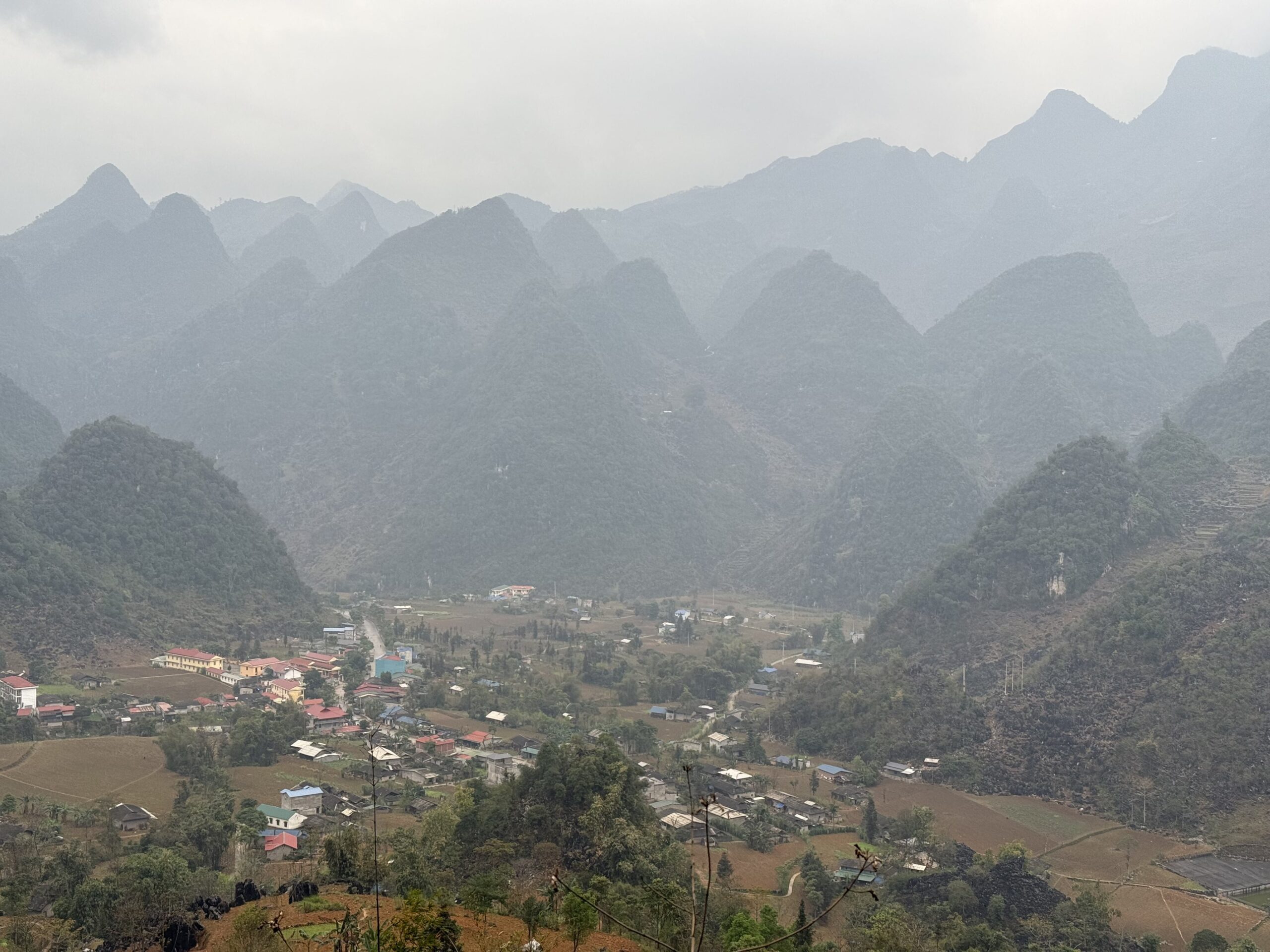
5. Local ethnic life: culture, homestays & cuisine
Lung Ho’s cultural landscape is primarily shaped by the Hmong and Tay ethnic groups, who maintain distinct traditions despite centuries of coexistence. The Hmong residents, predominantly from the Flower and Black Hmong subgroups, typically occupy higher elevations, their stone houses perched on hillsides. Their distinctive indigo-dyed clothing features intricate embroidery and batik patterns that indicate family lineage and marital status. The Tay people generally inhabit the lower village areas, traditionally constructing wooden stilt houses that keep living quarters elevated above the ground for protection from moisture and animals.
Social structures in Lung Ho remain largely traditional, with extended family compounds housing multiple generations. Village elders continue to hold significant decision-making authority, particularly regarding land use, dispute resolution, and ceremonial matters. Religious practices blend animism with ancestor worship, evident in household altars and seasonal rituals tied to agricultural cycles. During certain festivals, particularly around Lunar New Year (Tết), the village comes alive with ceremonial activities including buffalo sacrifices, ritual dances, and communal feasts that visitors may witness if timing their visit accordingly.
Homestay experiences offer the most immersive way to understand daily life in Lung Ho. Several families have modified traditional houses to accommodate guests while maintaining authentic character. These homestays typically feature shared sleeping areas on bamboo platforms with mosquito nets and comfortable bedding. Bathroom facilities range from basic to moderately improved, usually in separate structures. What these accommodations lack in luxury, they compensate for with warmth and cultural immersion. Evening gatherings often include storytelling, rice wine sharing, and sometimes impromptu musical performances using traditional instruments.
The local cuisine reflects the self-sufficient agricultural lifestyle of mountain communities. Meals center around mountain rice varieties, complemented by seasonal vegetables grown in family gardens or foraged from surrounding forests. Protein sources include free-range chickens, pork from black forest pigs, and occasionally beef or buffalo for special occasions. Distinctive dishes worth trying include thắng cố (a hearty stew traditionally made with horse meat but often prepared with other proteins for visitors), men mén (steamed corn flour resembling polenta), and various wild herbs that add unique flavors found nowhere else in Vietnam. Meals are typically enjoyed family-style, with everyone seated on low stools around shared dishes.
Visitors should observe certain cultural sensitivities when interacting with Lung Ho’s residents. Modest dress shows respect for local customs, particularly for women. Photography should always follow permission, especially during ceremonial activities or inside homes. When accepting the inevitable offers of rice wine (rượu), taking at least a symbolic sip acknowledges hospitality. Small gifts like tea, fruit, or school supplies for children are appreciated but not expected. These thoughtful approaches help ensure tourism positively impacts the community while preserving cultural dignity.
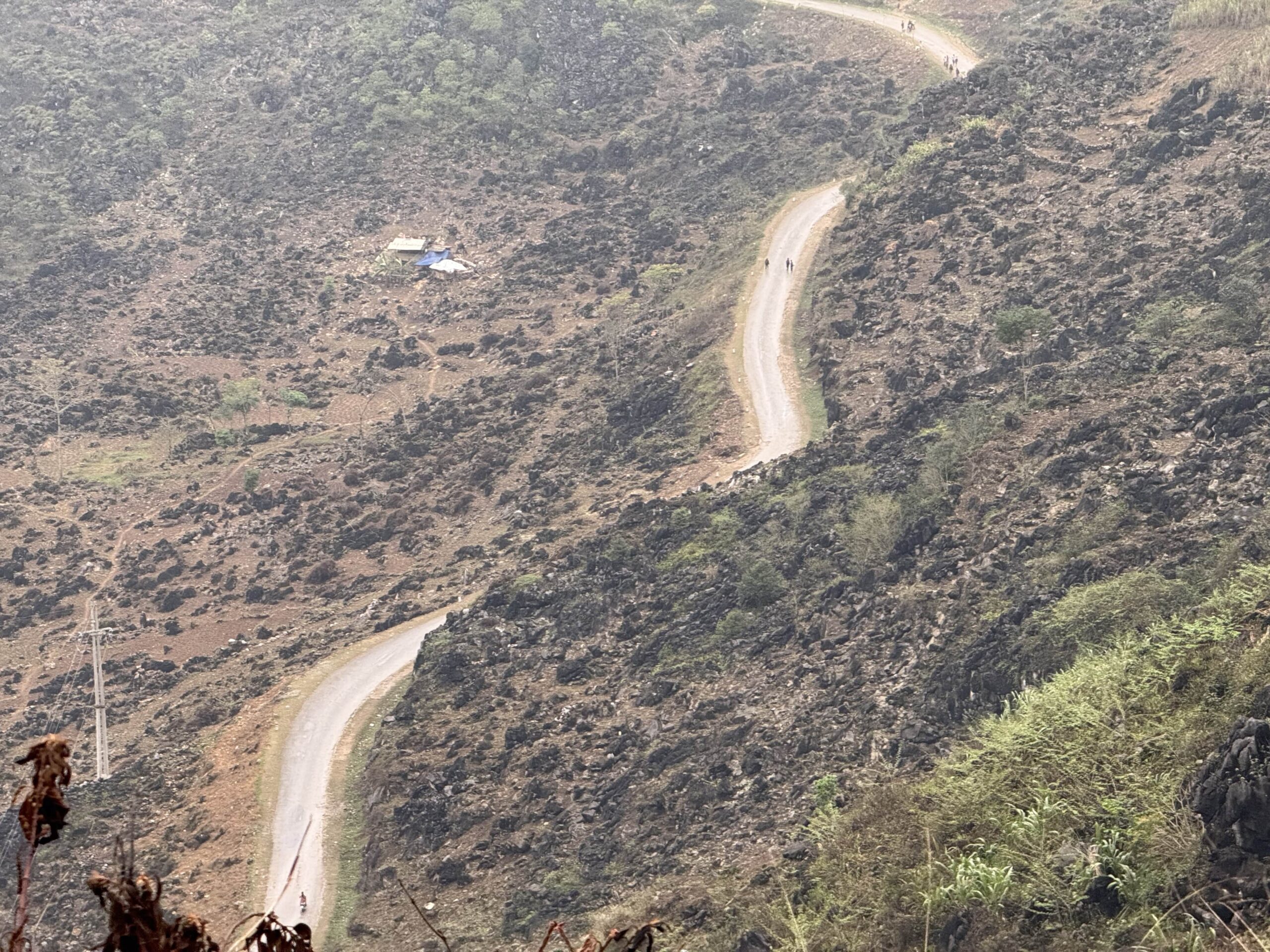
6. Lung Ho in the Ha Giang Loop: itinerary integration
Incorporating Lung Ho into your Ha Giang Loop journey requires thoughtful planning to balance this authentic experience with other highlights of the region. Based on Phieu Travel’s extensive experience guiding visitors through northern Vietnam, we’ve developed several approaches to seamlessly include Lung Ho while maintaining a manageable itinerary. The village works particularly well as either an overnight destination or an extended day visit, depending on your time constraints and travel preferences.
For those completing the traditional four-day Ha Giang Loop, Lung Ho fits naturally into the second or third day. A popular integration places it between Dong Van and Meo Vac, diverting from the main route for either a few hours or an overnight stay. This approach allows you to experience the famous Ma Pi Leng Pass in morning light before spending afternoon hours exploring Lung Ho’s cultural landscape. Alternatively, after visiting the Lung Cu Flag Tower in the morning, travelers can reach Lung Ho by early afternoon, spend the night in a homestay, and continue to Meo Vac the following day. This scheduling provides ample time for village exploration without rushing through other iconic loop destinations.
Weekend visitors working with a compressed three-day itinerary might consider making Lung Ho their primary cultural immersion point. Under this approach, the first day involves reaching Yen Minh from Ha Giang, the second day combining Dong Van and Lung Ho (with overnight in the village), and the third day continuing through Meo Vac before returning to Ha Giang. While this pace requires more driving hours on certain days, it prioritizes depth of experience over breadth, allowing meaningful engagement with Lung Ho’s community while still covering the loop’s major highlights.
Specialized photography or cultural itineraries benefit from dedicating two nights to Lung Ho as a base for exploration. This approach allows visitors to experience both early morning and late afternoon light conditions optimal for photography while using the middle day for more extensive trekking to outlying viewpoints and neighboring villages. From this base, day trips can reach major attractions like the Hmong King’s Palace or Lung Cu Flag Tower while returning to the peaceful village atmosphere each evening. This arrangement particularly suits travelers seeking deeper cultural immersion and opportunities to build relationships with local families.
Weather considerations significantly impact itinerary planning around Lung Ho. The ideal visiting periods span October to November and March to May, when clear skies enhance landscape photography and pleasant temperatures facilitate outdoor activities. December through February brings striking clear views but cold temperatures, requiring proper clothing for comfort, especially in homestays with limited heating. The summer monsoon season (June-September) presents challenges with occasional heavy rainfall affecting road conditions, but compensates with lush green rice terraces and fewer visitors. Phieu Travel recommends maintaining flexibility in your schedule during rainy periods, as weather conditions can sometimes necessitate itinerary adjustments.
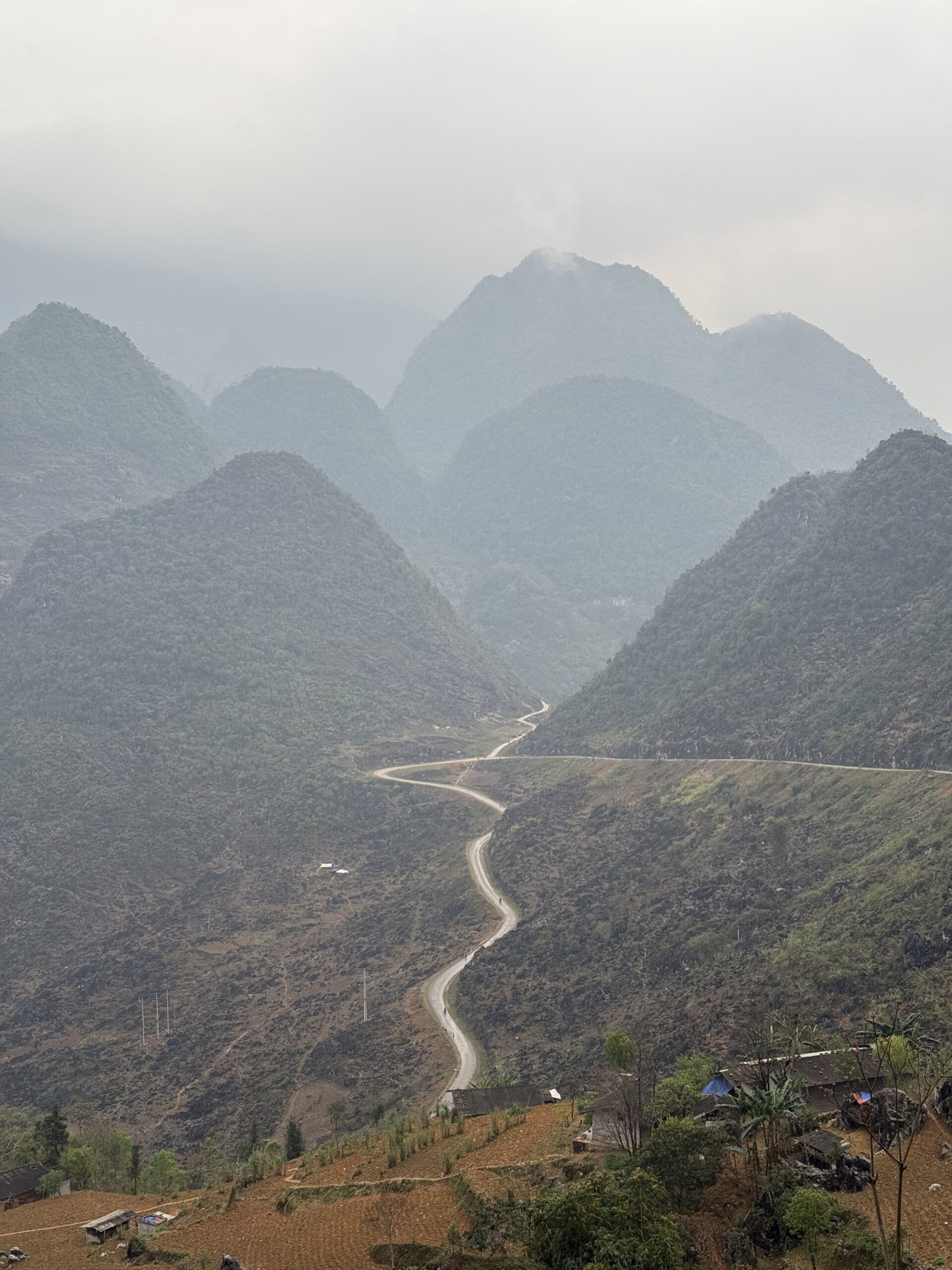
7. Practical tips for visiting Lung Ho
Visiting Lung Ho rewards preparation, as this remote location presents both unique opportunities and practical challenges. Based on Phieu Travel’s experience guiding numerous travelers through this region, we’ve compiled essential advice to enhance your journey while minimizing potential difficulties. These recommendations address everything from packing appropriately to navigating local customs and maximizing your experience in this special destination.
Pack thoughtfully for Lung Ho’s mountain climate and basic infrastructure. Layered clothing proves essential year-round, as temperatures fluctuate significantly between day and night even in summer months. A light rain jacket should always accompany you, regardless of forecast, as mountain weather changes rapidly. Sturdy walking shoes with good traction handle the village’s uneven stone pathways and surrounding trails. Additional essentials include a headlamp or flashlight (power outages occur regularly), portable battery pack, basic first aid supplies, and toilet paper. If staying overnight, bring a light sleeping bag liner for added comfort in homestay accommodations.
Communication presents challenges but creates meaningful opportunities. Few villagers speak English, making basic Vietnamese phrases extremely valuable. Translation apps with offline capability (like Google Translate with Vietnamese downloaded) prove helpful, particularly those with image translation features for reading signs or menus. Learning simple greetings in Hmong or Tay demonstrates respect and often opens doors to warmer interactions. Patience and creative non-verbal communication drawing pictures, using gestures, sharing photographs frequently overcome language barriers while creating memorable exchanges.
Financial preparations require forethought since Lung Ho has no ATMs or card payment facilities. Bring sufficient Vietnamese dong in small denominations (10,000-50,000 VND notes) for purchases, homestay payments, and additional experiences like guided treks. Prices in the village typically run lower than tourist centers, with homestays ranging from 150,000-250,000 VND per person including meals, and simple meals costing 30,000-50,000 VND. Handcrafted textiles represent the most significant potential purchases, with prices varying based on complexity and workmanship.
Respect for local customs enhances both your experience and your impact on the community. When visiting homes, remove shoes before entering living areas. During meals, wait for elders to begin eating before serving yourself. If invited to ceremonies or celebrations, bring a small gift (fruit, tea, or cookies work well) as a token of appreciation. Photography should always follow permission, particularly for portraits or inside homes. Women travelers should dress modestly, covering shoulders and knees, especially when visiting ceremonial spaces or participating in community events.
Timing considerations significantly affect what you’ll experience in Lung Ho. Market days (typically every sixth day in the lunar calendar) bring added vibrancy as villagers gather to trade goods. Agricultural seasons offer different visual landscapes late May shows newly planted rice terraces in bright green, September-October reveals golden harvest scenes, while winter months provide clearer mountain views but dormant fields. Festival periods, particularly around Lunar New Year (late January or February), showcase traditional ceremonies though accommodations become more limited as families host returning relatives.
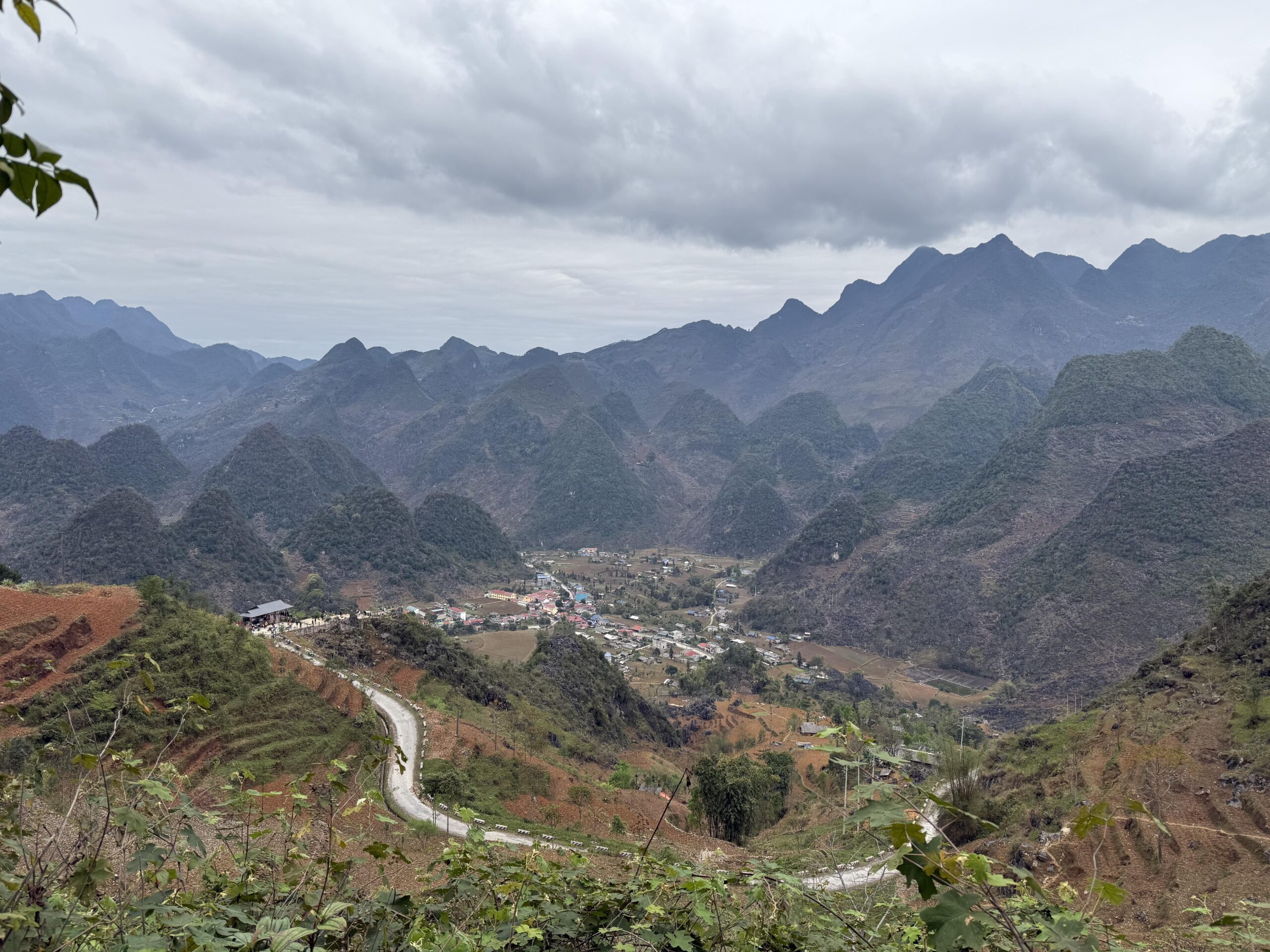
Lung Ho Ha Giang captivates visitors with its rare combination of dramatic natural beauty and living cultural traditions. Unlike more developed destinations on the Ha Giang Loop, this village offers an authentic window into highland life largely unchanged by tourism. Whether you’re trekking to panoramic viewpoints, learning traditional textile crafts from Hmong artisans, or simply sharing meals with homestay families, Lung Ho delivers the kind of meaningful encounters that transform a vacation into a genuine cultural exchange. As you plan your northern Vietnam adventure, consider giving Lung Ho more than just a passing visit it deserves time for deeper exploration and connection. For personalized itineraries that include this hidden gem alongside other Ha Giang highlights, visit us at Phieutravel.com.
Read more:
- Then Pa Village Ha Giang the essential guide to this hidden h’Mong gem
- Hoang Su Phi rice terraces ultimate travel guide 2025
- Ha Giang Jeep Tour by Phieu Travel: The Ultimate Adventure on the Ha Giang Loop (2025)
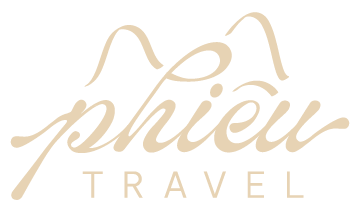

You Might Also Like
Ha Giang Weather in September: Complete Guide for Travelers
Exploring the magnificent Ha Giang Loop in September offers travelers a perfect balance of favorable[...]
Quan Ba Twin Mountains: Ha Giang’s Iconic Fairy Hills and Complete Travel Guide
The mystical Quan Ba Twin Mountains rise from the emerald valleys of Ha Giang like[...]
Vuong family mansion: the architectural marvel and cultural legacy of Ha Giang
Deep in Vietnam’s northern highlands, where mist-shrouded mountains meet terraced rice fields, stands a testament[...]
Ha Giang Loop Safety Tips: How to Ride Securely in Vietnam’s Northern Mountains
The Ha Giang Loop, with its winding mountain roads and breathtaking landscapes, offers one of[...]
The Ultimate Guide to the M-Shaped Curve on Ha Giang Loop
Vietnam’s remote northern province of Ha Giang hides a natural wonder that has captivated adventurous[...]
Most Beautiful Places to Visit in Vietnam: Essential Destinations and Insider Tips
Vietnam captivates travelers with its stunning landscapes, rich cultural heritage, and warm hospitality. From mist-shrouded[...]
Beyond the Beaten Path: Discovering Ha Giang Province in Northeast Vietnam
Ha Giang Province in Northeast Vietnam stands as one of the country’s last frontiers for[...]
Rainy season in Ha Giang: what to expect, when to go, and travel tips
Vietnam’s northern frontier reveals a different face during the rainy season, transforming Ha Giang’s limestone[...]